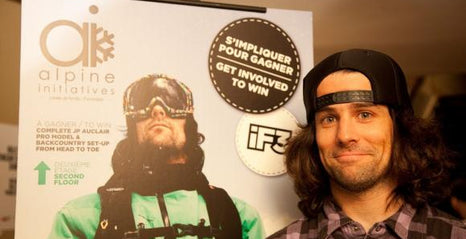Questions Extreme Sports Communities Find Themselves Asking
Extreme sports lead to extreme accidents. This past weekend I attended Red Bull Rampage - the largest and gnarliest downhill bike event in existence. It was my first Rampage experience, but I instantly understood that the course is insane. Imagine the most exposed mountain face you can find in a ski flick, take away the snow and padding that ski clothing provides, and send it all on two wheels. Ready, set... GO! And lets not forget the impressive dig crews who shape the venue while on belay during the days leading up to the event. Rampage brought to my mind all the risks we take through freeskiing, but with more immediate and intense consequences.

Paul Basagotia suffered these consequences during his run at Rampage. He is currently in the ICU, fighting to regain feeling in his legs after shattering his T12 vertebra; an injury sustained during a fall of the like no one would care to witness, let alone experience. From my position in the venue, only a cloud of red dust could be seen. Within two minutes a helicopter swooped in and succeeded in a near dirt-blinded landing to take him to the hospital. We are all rooting for Paul’s speedy and full recovery.

Following Paul’s accident, several pieces of writing have brought to light aspects of this sport that few have first hand experience in. One blog is from Lacy Kemp, whose profession revolves around action sports marketing and who is an extremely impressive mountain biker herself. Another is a powerful opinion piece from biker and VitalMTB content manager, Brandon Turman.
Skiing undoubtedly has it’s fair share of accidents; according to Turman’s article, 7 out of 42 Rampage riders ended up in the hospital this year. That’s 17% of the participants – an extremely high risk for not close to enough reward. In fact, there were athletes who, as Kemp writes it, “refused to ride their second runs because the scoring was such that in order to win, they may be on a suicide mission.” Both articles question the responsibility of athletes, sponsors, and ourselves as viewers and participants of these sports, questions that similarly echo throughout the ski industry. Our communities push for the next best thing while simultaneously asking to tone it down.
One consistently asked question is where should the “progression” line be drawn? What does “progression” even mean? That’s always been a loaded word so I’ll leave it up to healthy debate. In their articles, Kemp and Turman point out the draw to these events, the notions of which are not unlike those extreme skiers face. The cameras are rolling, the hope of success, the fear of failure, the regret of backing out. No one is pointing a gun to our extreme sports loving heads, yet we choose to participate in things that scare the bajeezus out of us, we’re just weird that way. Activities like these are what create the communities we attach ourselves to and grow from. Our passions are molded through them and the athletes who shape these sports become our inspiration, heroes, and legends.
No one is advocating for the disappearance of this elite level in any action sport, but sometimes these accidents beg the question: how much do competitions like Rampage, the X Games, or the Freeride World Tour influence injuries? The purpose is clearly to push the limits, but the limits of what? In the freeski world we run the risks that come with sending it off massive park jumps and sliding impossible urban city rails. We dream of dropping snow-covered cliffs and dare to venture to remote areas, outside of avy patrolled zones.

Sometimes accidents happen because of, or in preparation for, these competition (or film) platforms. Others are random and unfortunate occurrences; doing something we’ve done a million times. Jamie Crane-Mauzy is now on the road to a full recovery after a traumatic brain injury that put her into a coma last spring. Jamie told me that she can’t say one way or another if her accident was due to “pushing” the sport at the World Skiing Invitational or if it was simply just that - an accident. “I had done double flips for five years before I got hurt doing basically the same flip,” she said. It is not an uncommon story, and we are so thankful that our friends have recovered from these traumas while we grieve for those who do not.
In the end, to reiterate Kemp and Turman’s thoughts, these impressive athletes who risk their health for their chosen profession are at the core of the sports survival. They keep the passion alive and we want them to continue to do so. “Progression” is not worth the lives of our icons, however they do need to make a living and that’s not achieved by being stagnant. What are your thoughts? Where do extreme sports go after reaching Rampage caliber?
By AI intern, Katie Hitchcock

Paul Basagotia suffered these consequences during his run at Rampage. He is currently in the ICU, fighting to regain feeling in his legs after shattering his T12 vertebra; an injury sustained during a fall of the like no one would care to witness, let alone experience. From my position in the venue, only a cloud of red dust could be seen. Within two minutes a helicopter swooped in and succeeded in a near dirt-blinded landing to take him to the hospital. We are all rooting for Paul’s speedy and full recovery.

Following Paul’s accident, several pieces of writing have brought to light aspects of this sport that few have first hand experience in. One blog is from Lacy Kemp, whose profession revolves around action sports marketing and who is an extremely impressive mountain biker herself. Another is a powerful opinion piece from biker and VitalMTB content manager, Brandon Turman.
Skiing undoubtedly has it’s fair share of accidents; according to Turman’s article, 7 out of 42 Rampage riders ended up in the hospital this year. That’s 17% of the participants – an extremely high risk for not close to enough reward. In fact, there were athletes who, as Kemp writes it, “refused to ride their second runs because the scoring was such that in order to win, they may be on a suicide mission.” Both articles question the responsibility of athletes, sponsors, and ourselves as viewers and participants of these sports, questions that similarly echo throughout the ski industry. Our communities push for the next best thing while simultaneously asking to tone it down.
One consistently asked question is where should the “progression” line be drawn? What does “progression” even mean? That’s always been a loaded word so I’ll leave it up to healthy debate. In their articles, Kemp and Turman point out the draw to these events, the notions of which are not unlike those extreme skiers face. The cameras are rolling, the hope of success, the fear of failure, the regret of backing out. No one is pointing a gun to our extreme sports loving heads, yet we choose to participate in things that scare the bajeezus out of us, we’re just weird that way. Activities like these are what create the communities we attach ourselves to and grow from. Our passions are molded through them and the athletes who shape these sports become our inspiration, heroes, and legends.
No one is advocating for the disappearance of this elite level in any action sport, but sometimes these accidents beg the question: how much do competitions like Rampage, the X Games, or the Freeride World Tour influence injuries? The purpose is clearly to push the limits, but the limits of what? In the freeski world we run the risks that come with sending it off massive park jumps and sliding impossible urban city rails. We dream of dropping snow-covered cliffs and dare to venture to remote areas, outside of avy patrolled zones.

Sometimes accidents happen because of, or in preparation for, these competition (or film) platforms. Others are random and unfortunate occurrences; doing something we’ve done a million times. Jamie Crane-Mauzy is now on the road to a full recovery after a traumatic brain injury that put her into a coma last spring. Jamie told me that she can’t say one way or another if her accident was due to “pushing” the sport at the World Skiing Invitational or if it was simply just that - an accident. “I had done double flips for five years before I got hurt doing basically the same flip,” she said. It is not an uncommon story, and we are so thankful that our friends have recovered from these traumas while we grieve for those who do not.
In the end, to reiterate Kemp and Turman’s thoughts, these impressive athletes who risk their health for their chosen profession are at the core of the sports survival. They keep the passion alive and we want them to continue to do so. “Progression” is not worth the lives of our icons, however they do need to make a living and that’s not achieved by being stagnant. What are your thoughts? Where do extreme sports go after reaching Rampage caliber?
By AI intern, Katie Hitchcock


